
黄宾虹(1865年1月27日—1955年3月25日),名懋质,字朴存,亦称朴人、朴丞、劈琴,号宾虹,复号朴存、予向、滨虹散人、虹若、虹庐、虹叟、黄山山中人。其父黄定华,商贾之余,亦工书画。宾虹幼抱才气,五岁入塾,早嗜丹青,篆刻亦佳。八年丁酉(1881年)师从陈春帆学画;丙戌(1886年),习画于郑姗,并得陈若水传授花鸟之术;六载,能临摹家藏沈廷瑞之山水,后因师倪逸甫,亦学画篆刻。
光绪三十三年后,避居上海三十载。卅七年迁北平,职于故宫、国画研究院、北平艺专。四十八年归杭州,任职斯地。中华人民共和国成立,拜为中国美术家协会华东分会副主席,任中央美术学院教授。及其九十之寿,国赐“中国人民优秀画家”之誉,誉曰“再举新安画派大旗,终成一代宗师”。
Huang Binhong, originally named Maozhi, styled Pucun, also known as Pureman, Pucheng, Piqin, and by the sobriquets Binhong, Pucun, Yuxiang, Bin Hong Sanren, Hong Ruo, Hong Lu, Hong Sou, and Huangshan Mountain Man. His father, Huang Dinghua, was a businessman who also excelled in calligraphy and painting. Binhong showed talent from a young age; he entered a private school at the age of five and soon developed a fondness for painting and seal carving. In the year 1881, he studied painting under Chen Chunfan; in 1886, he learned landscape painting from the artist Zheng Shan and studied flower and bird painting with Chen Ruoshui; by the age of six, he could copy the landscape paintings in his family's collection by Shen Tingrui, and later studied painting and seal carving under Ni Yifu.
After the thirty-third year of the Guangxu period (1907), Huang Binhong lived in Shanghai for thirty years. In 1937, he moved to Beiping (now Beijing), where he worked at the Forbidden City, the National Academy of Chinese Painting, and the Beiping Art Professional School. In 1948, he returned to Hangzhou for a position there. After the establishment of the People's Republic of China, he served as the Vice Chairman of the East China Branch of the Chinese Artists Association and a professor at the Central Academy of Fine Arts. On his ninetieth birthday, he was honored by the nation with the title "Outstanding Painter of the Chinese People," acclaimed as "the one who raised the banner of the New Anhui School of Painting again, ultimately becoming a grandmaster of his generation."
黄宾虹善执笔绘山河,通美术史论,工书篆,善吟咏。其画风浑厚多变,笔墨丰润,承载深邃民族文化之精神及自然之美学。画作融古融今,变化无端,自成一格。墨法合篆籀之意,笔重墨厚,刚中含柔,精墨之法,用破墨、积墨、宿墨,布局虽杂而有序,不整而整齐,纵多而不闷,疏而不虚,尤妙用“黑密厚重”四技,写尽山川之气象。偶涉花鸟虫鱼,皆清逸超脱,水流花开之景,妙不可言。
其山水画,淋漓尽致显书法之功,千笔万笔,看似无序,实则脉络清晰,无一笔赘述。骨线虽少,力透纸背,每一笔皆秦汉之力,辅线纷陈错落,绘成千态自然风貌。宾虹,学者也,其艺术独树一帜,非循俗迎合,其深意与价值,未获世人充分识,需时日以渐明。
Huang Binhong excels in painting landscapes, understands the history of art, is skilled in calligraphy and seal carving, and is adept at poetry. His painting style is profound and varied, with rich ink and brushwork that carries the deep spirit of national culture and the aesthetics of nature. His artworks blend the ancient with the modern, featuring endless transformations, forming a unique style of his own. His ink technique incorporates the essence of seal script, his strokes are heavy and ink-laden, combining firmness with gentleness. Mastering the use of broken, accumulated, and aged ink, his layouts, though complex, are orderly; unaligned yet aligned, abundant but not dull, sparse yet substantial, especially skilled in the "dark, dense, thick, heavy" techniques, fully capturing the essence of mountains and rivers. Occasionally, he also paints flowers, birds, insects, and fish, each exuding a refined and ethereal beauty, capturing the enchanting scenes of flowing water and blooming flowers, indescribably wonderful.
His landscape paintings vividly showcase his calligraphic skills, with thousands of strokes that seem disordered at first glance but are actually interconnected, each one essential. Although sparing in his use of bold lines, each stroke carries the weight of the Qin and Han dynasties. Auxiliary lines are intricately woven, creating a rich tapestry of natural scenery. Huang, a scholar himself, possesses a unique artistic identity that does not conform to conventional tastes. His profound meanings and values have not yet been fully recognized by the public, and understanding them will take time.


《山川卧游图卷》始,微舟一叶,随流而下,舟中独行者穿林度桥,双岸木密山连,偶有炊烟升起,最终画至家门前,门内小犬守望,宁静悠然。此卷,黄宾虹匠心独具,借书法笔意以代画法,所谓“五笔七墨”,于“平、圆、留、重、变”及“浓、淡、破、泼、焦、宿、渍”之中,以宿墨尤为人称道,满幅点线,树山水,皆显生动之气息。
"The Mountain and River Leisurely Tour Scroll" begins with a small boat flowing downstream, carrying a lone traveler through forests and over bridges, with dense trees and continuous mountains on both banks and occasional wafts of cooking smoke rising. At the end, the boat reaches a house where a small dog stands guard, embodying tranquility. This scroll, a testament to Huang Binhong's unique artistry, replaces traditional painting techniques with calligraphic strokes, celebrated as "five brush techniques and seven ink techniques," including "level, round, reserved, heavy, change" and "thick, thin, broken, splashed, scorched, aged, soaked." Among these, the aged ink technique is particularly acclaimed, making every dot and line, every tree, mountain, and river burst with vivid life.


《松雪诗意图》,亦名《松风高隐图》,图中古松挺立于险峰之巅,亭中高士悟道修行,山势险峻,远峰如梦如幻。此作黄宾虹早年之笔迹,墨色深厚,具北派山水之峻挺,被列为“南黄北齐”之一,与齐白石齐名。早年师从李程髡弘诸家,兼学元明,重视布局之虚实繁简,笔如篆籀,墨势雄健,随笔处显纵横奇趣。
"The Pine and Snow Poetic Imagery Scroll," also known as "High Hermit in Pine Wind," features ancient pines standing tall among precipitous peaks, with a sage meditating in a pavilion, embodying the rugged mountain terrain, and distant peaks emerging like a dream. This work from Huang's early years is marked by a deep ink color, embodying the bold style of Northern landscape painting. Titled "South Huang and North Qi," he is paralleled with Qi Baishi. His early studies under masters like Li Liufang and Cheng Sui, and influences from Yuan and Ming dynasties, emphasize a balance of void and substance in composition, with brushwork as robust as carved seals, bringing dynamic intrigue to each stroke.

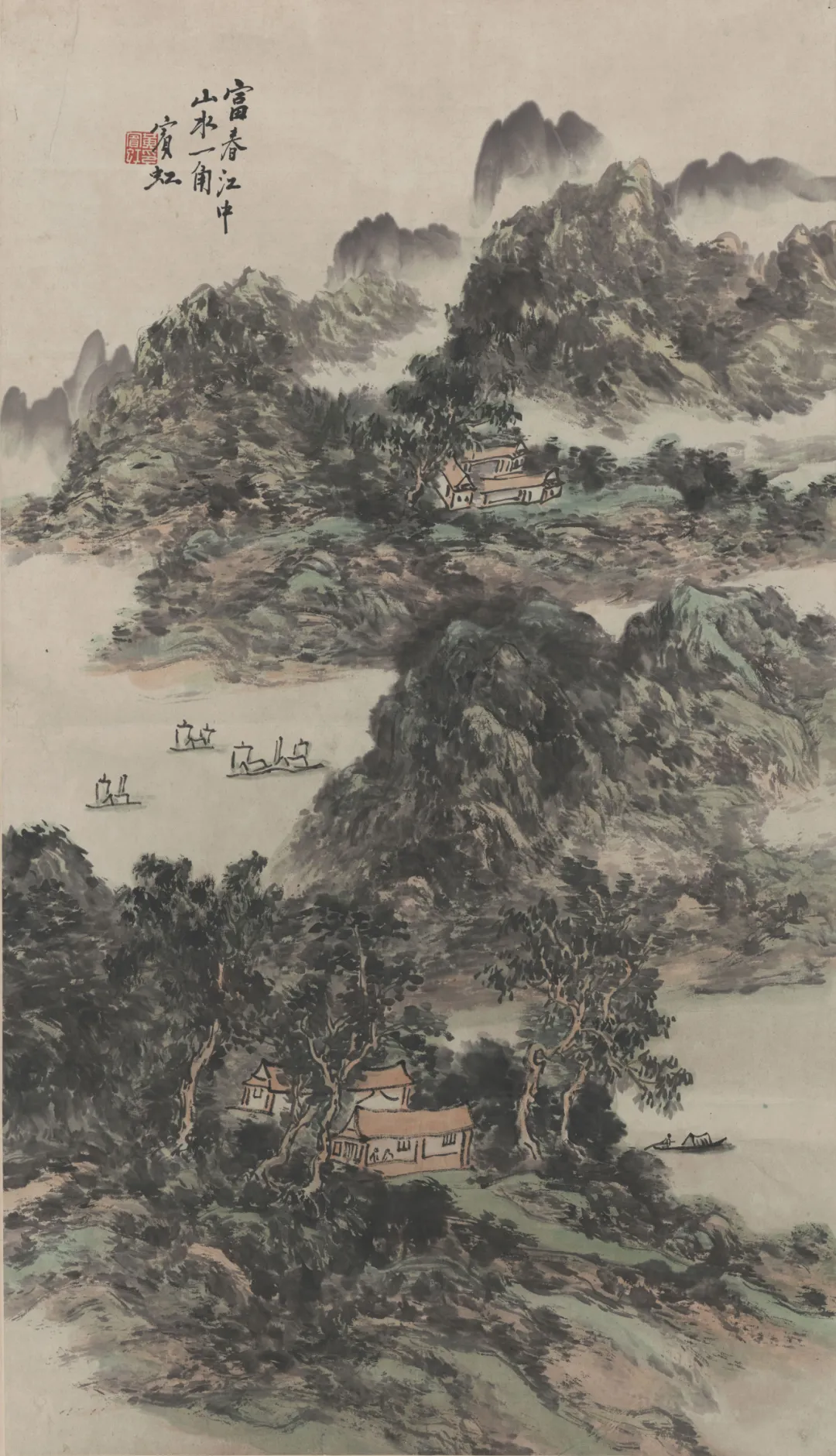
《富春江图》无年款,推断为晚期佳作,宾虹论山水,以“浑厚华滋”为美,技法之得首由临摹始,敢于创新,取法造化,心源自得。长久之研习实践,此幅远山用笔繁密,近水岸密笔重色,留白处由山脉延伸而断,构图繁简相宜,解决了笔墨之压迫感,体现“密不通风,疏可走马”之美学观。
"The Fuchun River Scroll," undated, is inferred to be a late masterpiece. Huang’s discourse on landscape painting centers on the aesthetic of "rich and lush beauty," beginning with meticulous replication and daring innovation, deriving from the essence of nature. Long-term study and practice manifest in dense brushwork on distant mountains and intense colors near the riverbanks, with strategic white space broken by extending mountain ranges, achieving a composition that balances complexity and simplicity, thus resolving the visual pressure of dense ink, embodying the aesthetic principle of "so dense no wind passes through, so sparse a horse could pass."

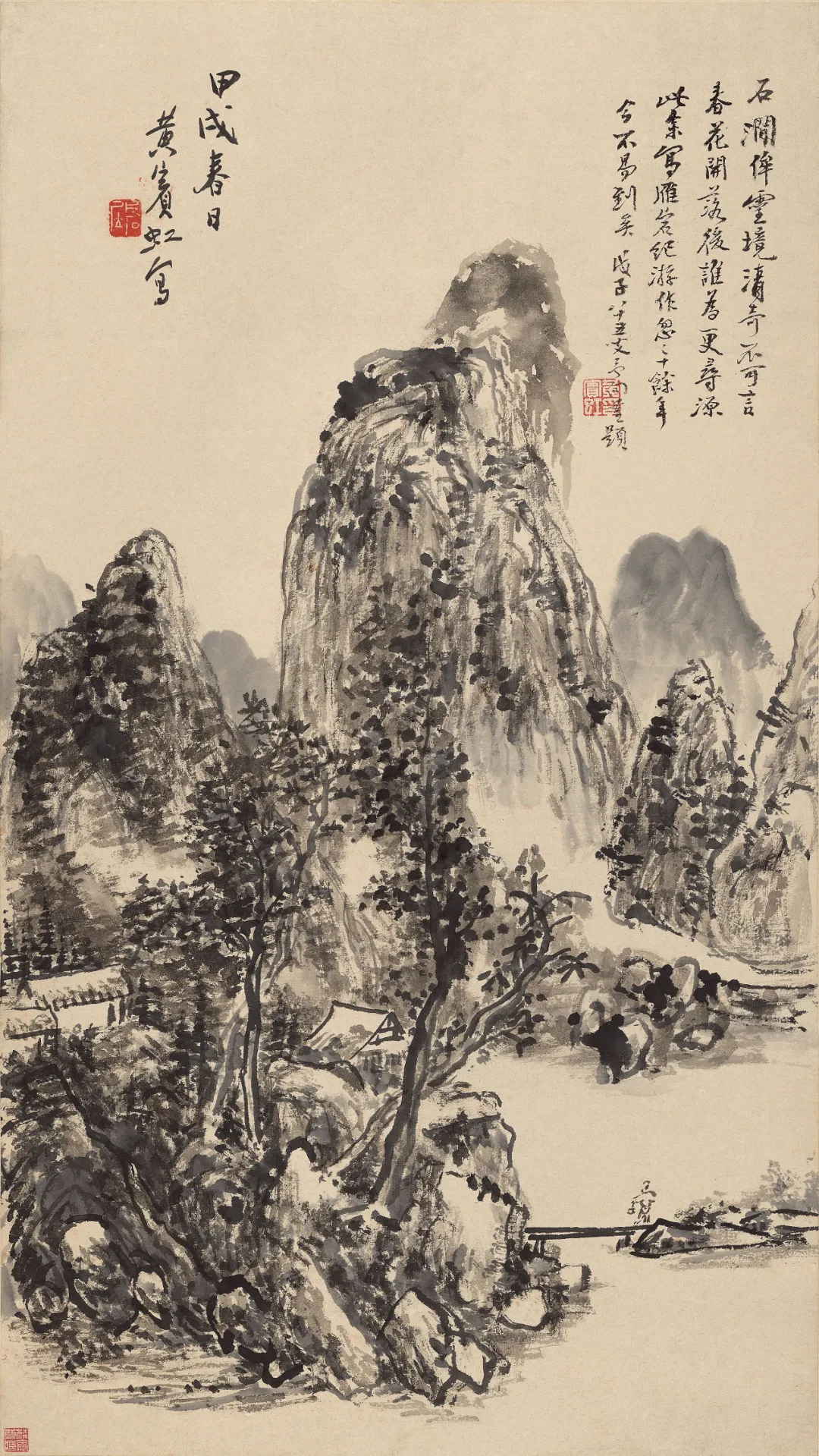
《春日山水图》大约创于黄宾虹五十年龄,为撰《雁宕记游》时作。二十年后再题跋,此间,黄宾虹已发表“五笔七墨”之说。1932年游蜀,观雪山后,作《青城烟雨》,展现新技法之始。此期理论与技法渐趋成熟,晚年由“白宾虹”转“黑宾虹”,追求之笔法线条已显老态。
"The Spring Day Landscape Scroll," created around the age of fifty during the composition of "Records of Mount Yandang," was revisited with a new colophon twenty years later. By this time, Huang had already introduced his renowned "five brushes and seven inks" concept. In 1932, his travels through Sichuan and the snowy mountains inspired "Misty Rain in Qingcheng," marking the emergence of his new painting technique. This period signifies the maturation of his theories and techniques, transitioning from "White Huang" to "Black Huang" in his later years, with his pursuit of brushwork and line art displaying a seasoned quality.


《溪桥烟霭图》采左山右水构图,山势层叠,近景坡岸渐缓,一桥连岸。桥头草屋,二士至桥畔议。中景山渐升,杂树繁茂;远山如屏。舟人摇浆,送客至岸。画家以水墨青绿,留白处描摹云岚,以积墨破墨渍墨,水墨淋漓,不求气韵而气韵自生。
"The Misty Bridge Over Stream Scroll" employs a left-mountain-right-water composition, with cascading terrain and a gently sloping near bank connected by a bridge. A thatched cottage at the bridge's head and two scholars by the bridge discuss poetically. The middle ground rises gently with scattered trees, while distant mountains stand like screens. Boatmen paddle, transporting guests across the river. The artist uses ink and shades of green, supplemented by white space to depict clouds and mountains, applying layered ink, broken ink, and soaked ink techniques, achieving a natural charm without deliberate seeking.

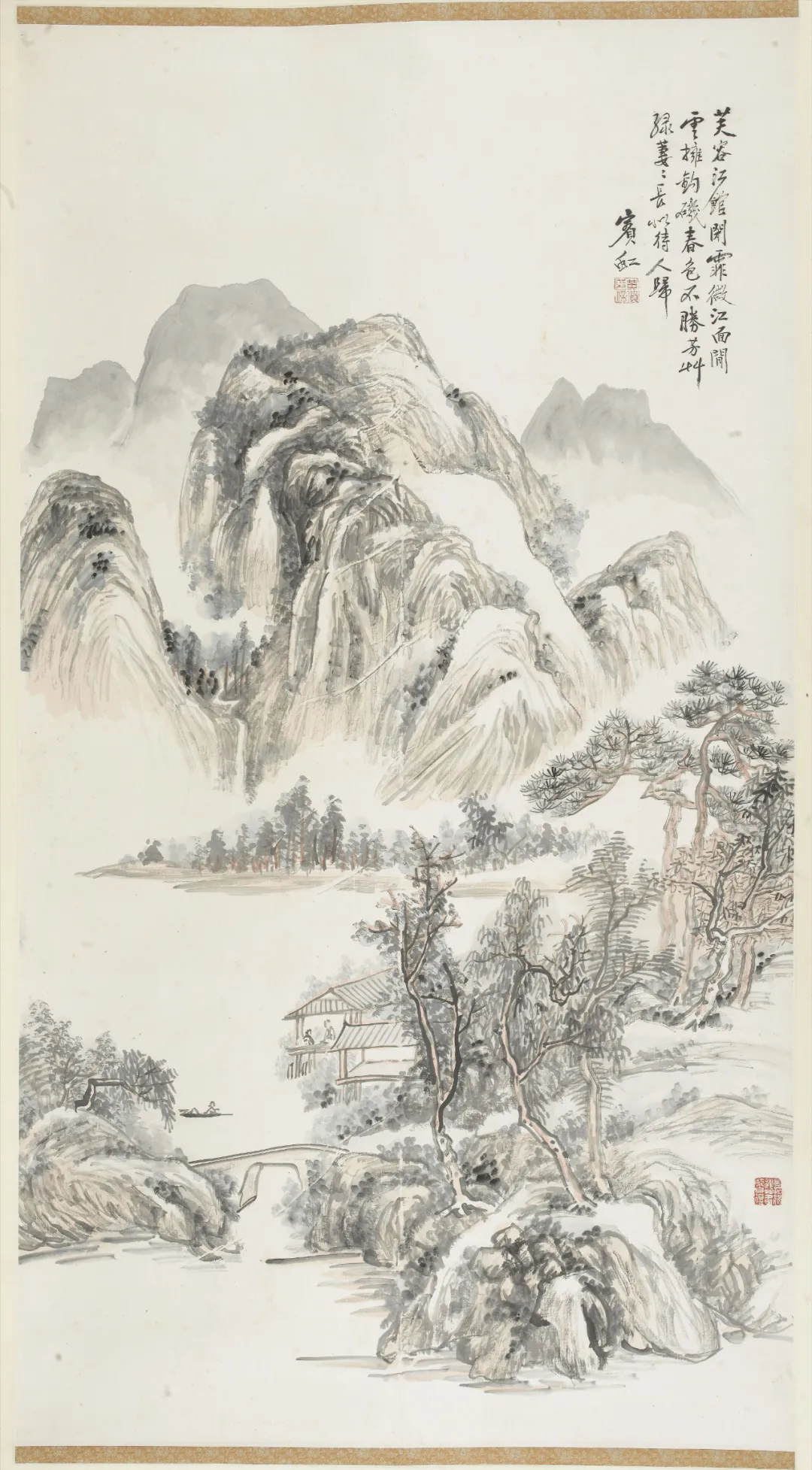
《芙蓉江馆图》环绕树木葱郁,小桥联岸,江上舟往来,馆中人交谈,对岸高山耸立。色彩浅绛,显示黄宾虹由清逸至浑厚华滋之转变。虽未用重墨,墨层已显,用笔刚劲,关联其推崇“金石运动”之美学。
"The Hibiscus River Pavilion Scroll" is surrounded by lush trees with a small bridge connecting the banks, boats plying the river, and people conversing inside the pavilion, with towering mountains opposite. The light rouge coloring indicates Huang's transition from ethereal to a more substantial lushness. Although not using heavy ink, the layering of ink is apparent, and the brushwork is vigorous, linked to his admiration for the "metal and stone movement" in aesthetics.

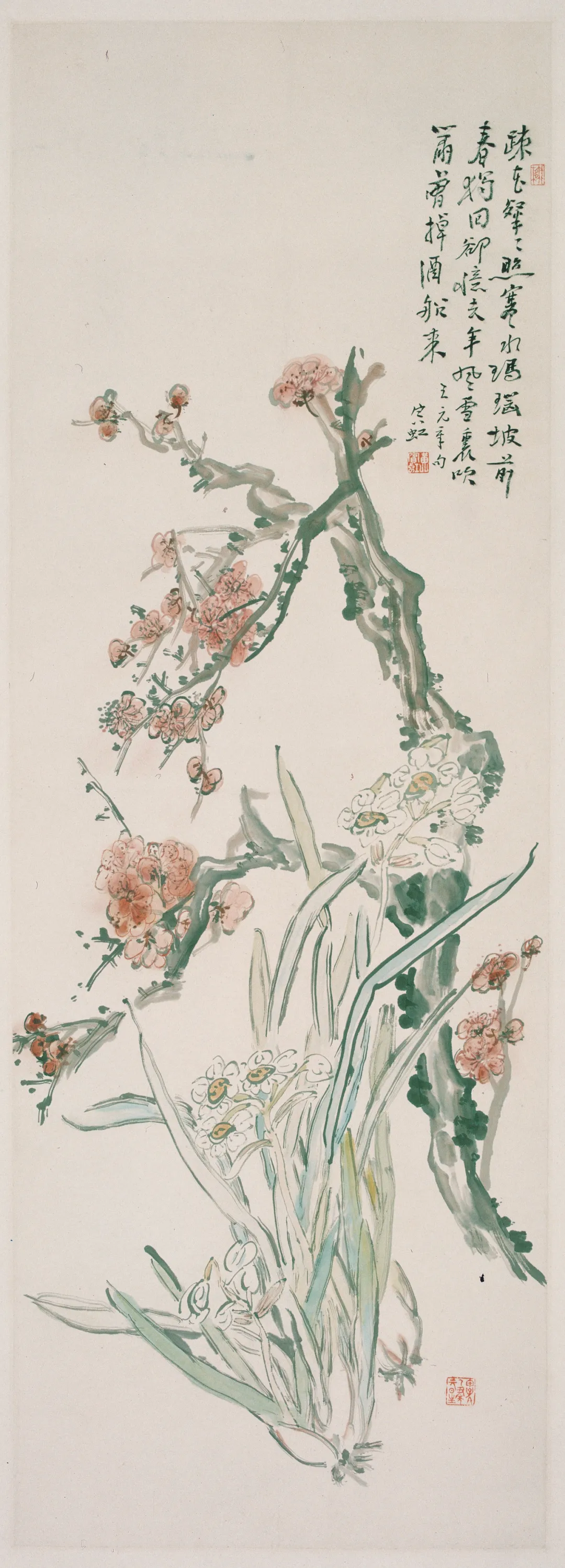
《花卉条幅》绘梅兰,以色为主,墨为辅,色墨结合,渍墨法在花鸟画中化为渍色法,拓展传统技法。笔法简约而意足,多折枝式,求墨色淡逸,变种用色。
"The Floral Scroll" depicts plum and orchid blossoms, prioritizing color over ink, blending both elements and adapting the landscape technique of soaked ink into a floral painting technique called soaked color, expanding traditional methods. The brushwork is simple yet sufficient, often in a broken-branch style, seeking light and ethereal ink colors, varying in hues.


《花卉条幅之二》绘两种花卉,红花次第开放,相生相依,色泽各异,轻墨增花瓣之厚重感,石绿点花托,枝干中锋挺拔,墨叶浓淡及老新分明,叶脉以浓墨,下方蝴蝶兰艳开,花根以淡墨铺开,浓墨点厾,线条辅之,右侧有竹干石头,墨色清淡,线条硬朗。
"The Second Floral Scroll" portrays two types of blossoms, with sequentially blooming red flowers supporting each other, exhibiting varied colors, lightly enhanced by thin ink to add depth to the petals, and emerald touches to the flower supports. The branches are boldly drawn, with variegated ink on leaves distinguishing old from new, and veins marked in dense ink. Below, a vibrant orchid blooms, with its base spread in light ink and details in dense ink, complemented by line work, with bamboo and rocks on the right, featuring light ink and firm lines.

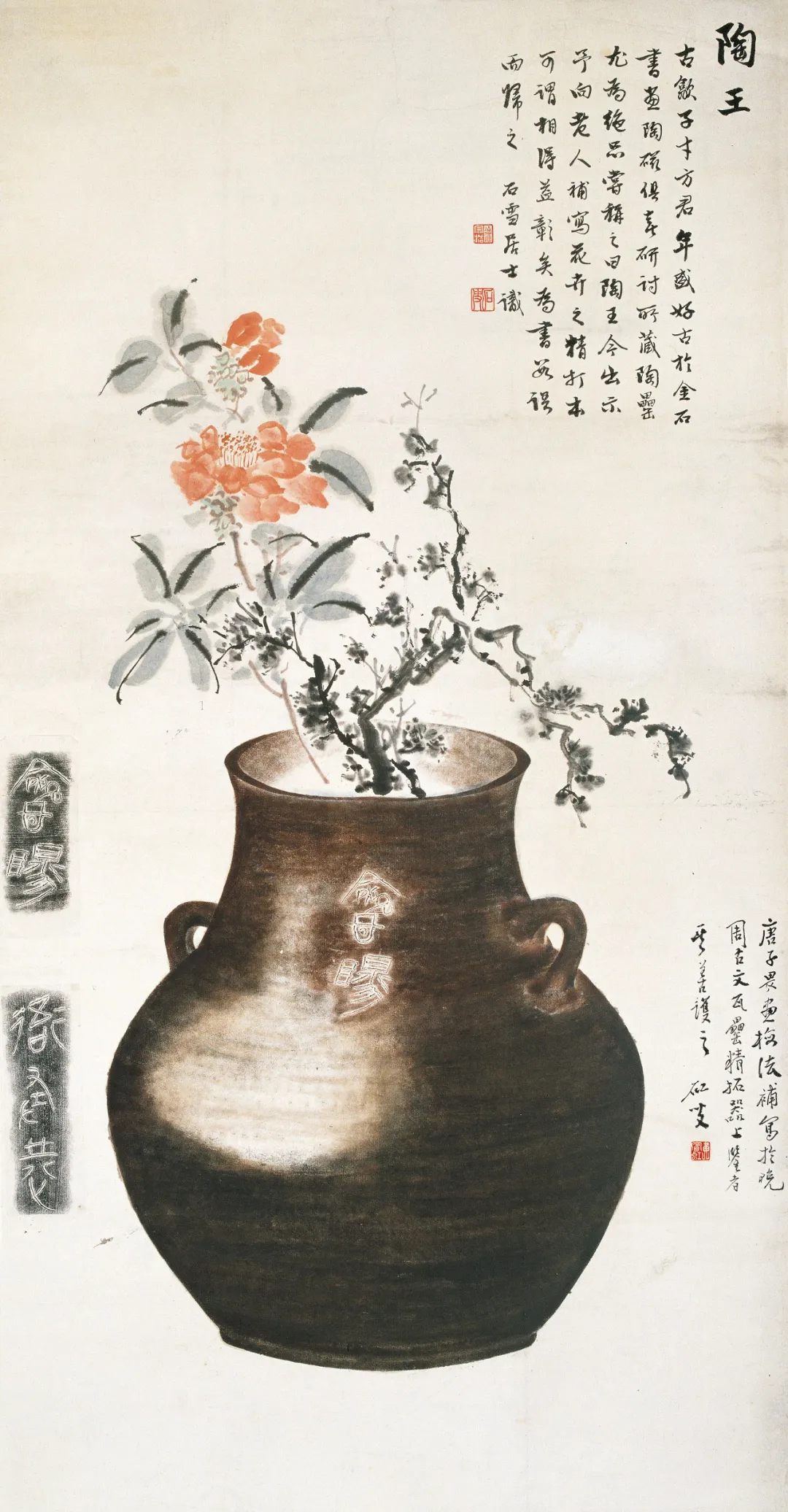
《陶王图》,源自友人所藏晚周古文瓦蹴拓片,誉为“陶王”。黄宾虹应邀,仿唐子畏画梅法,写实古陶,写意花卉。兼具写实与写意,拓印西周古文,临摹古字,虚实结合,意境幽远,古意盎然。
"The King Tao Scroll," originating from a friend’s collection of late Zhou dynasty ancient scripts, revered as "King Tao." Huang, invited to appreciate and add to the piece, emulates Tang Ziwei's plum painting style, realistically depicting ancient pottery and impressionistically portraying flowers. The artwork combines realism and impressionism, imprinting ancient Zhou script, meticulously copying ancient characters, merging reality with imagination, offering a profound and ancient charm.

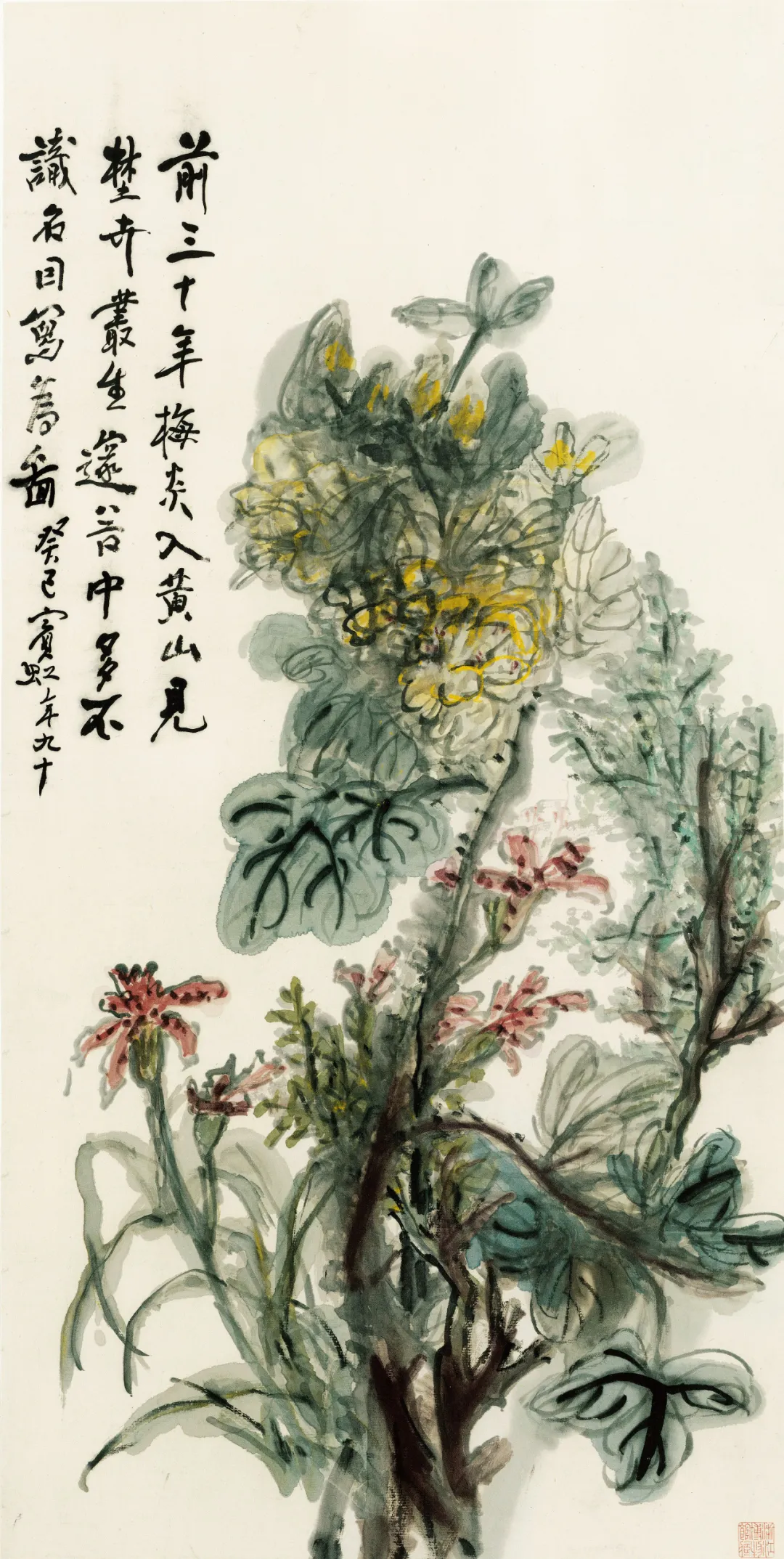
《黄山野卉图》表宾虹念故里黄山之情。笔墨丰润,色彩斑斓。潘天寿赞其:“世知山水之妙,不知花鸟更妙,妙在自在之中”。画面清新,色墨浑然一体,生动自然。
"The Wild Flowers of Yellow Mountain Scroll" expresses Huang’s affection for his native Yellow Mountain. Rich in ink and vibrant in color, Pan Tianshou praised, "People know Huang's landscapes are exquisite, but his floral and bird paintings are even more so, excelling in their natural ease." The painting is fresh and moist, with colors and ink blending seamlessly, vividly alive.

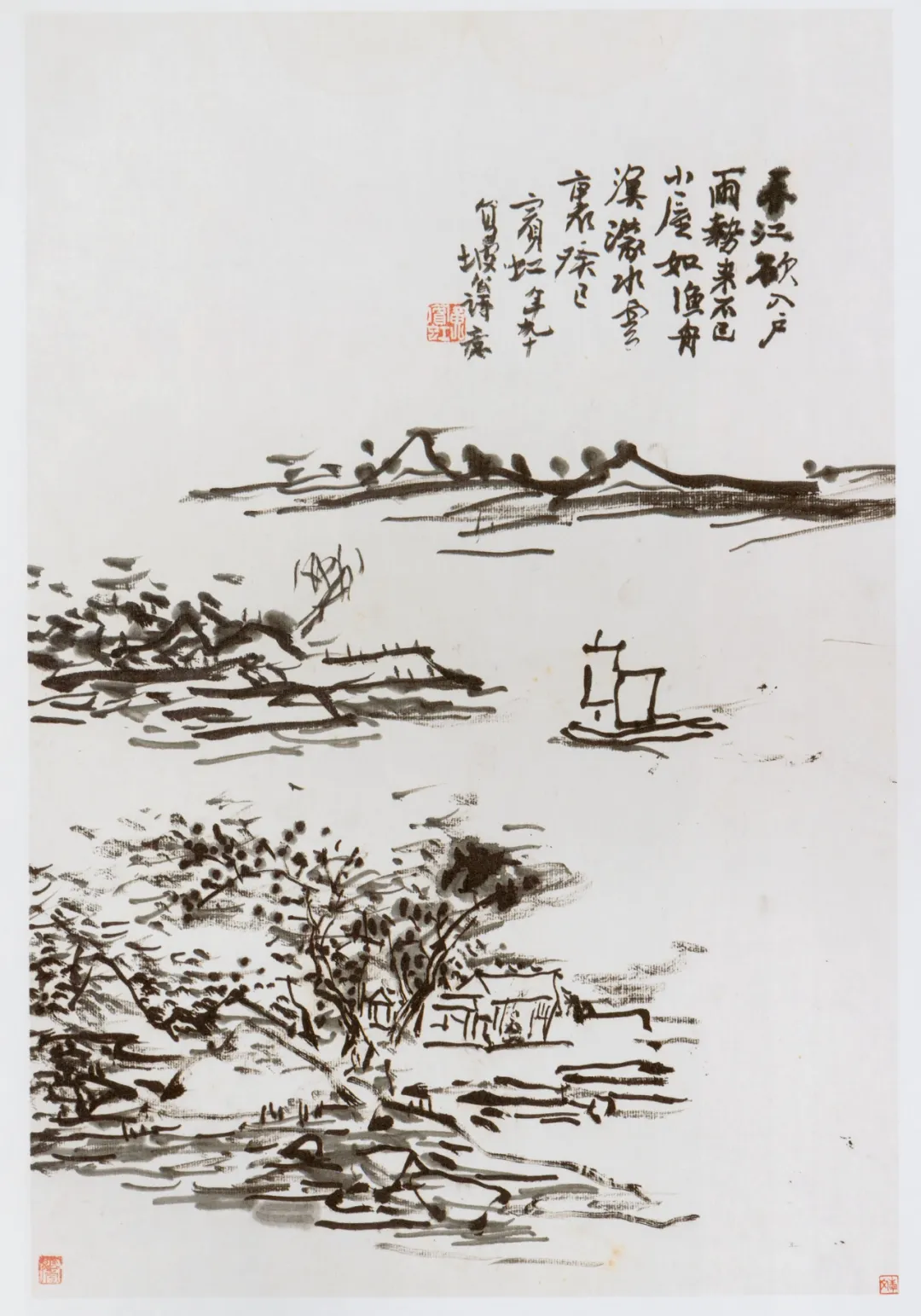
《春江图》绘春江澎湃,巨浪滔天,如怒龙冲门,雨势如瀑,绵绵不绝。茅屋若浮舟,漂泊于无边烟水之中。岸边杂树斜石及数茅舍若隐若现,双帆舟微见。狂风挟雨肆虐,画者以墨线勾勒,湿笔晕染,以渍墨渍色,书法短线与墨点,精妙捕捉风雨之狂态,场景生动至极。
"The Spring River Scroll" depicts the tumultuous spring river, with towering waves like a raging dragon bursting through the gate, rain pouring endlessly. Thatched cottages float like boats on boundless misty waters. Randomly placed small trees, sloped stones, and a few thatched huts are barely visible, with two small sailboats glimpsed. The violent storm and rain are masterfully captured with ink lines and wet brush blending, soaked ink and color, and calligraphic short lines and ink dots, vividly portraying the tempestuous scene.

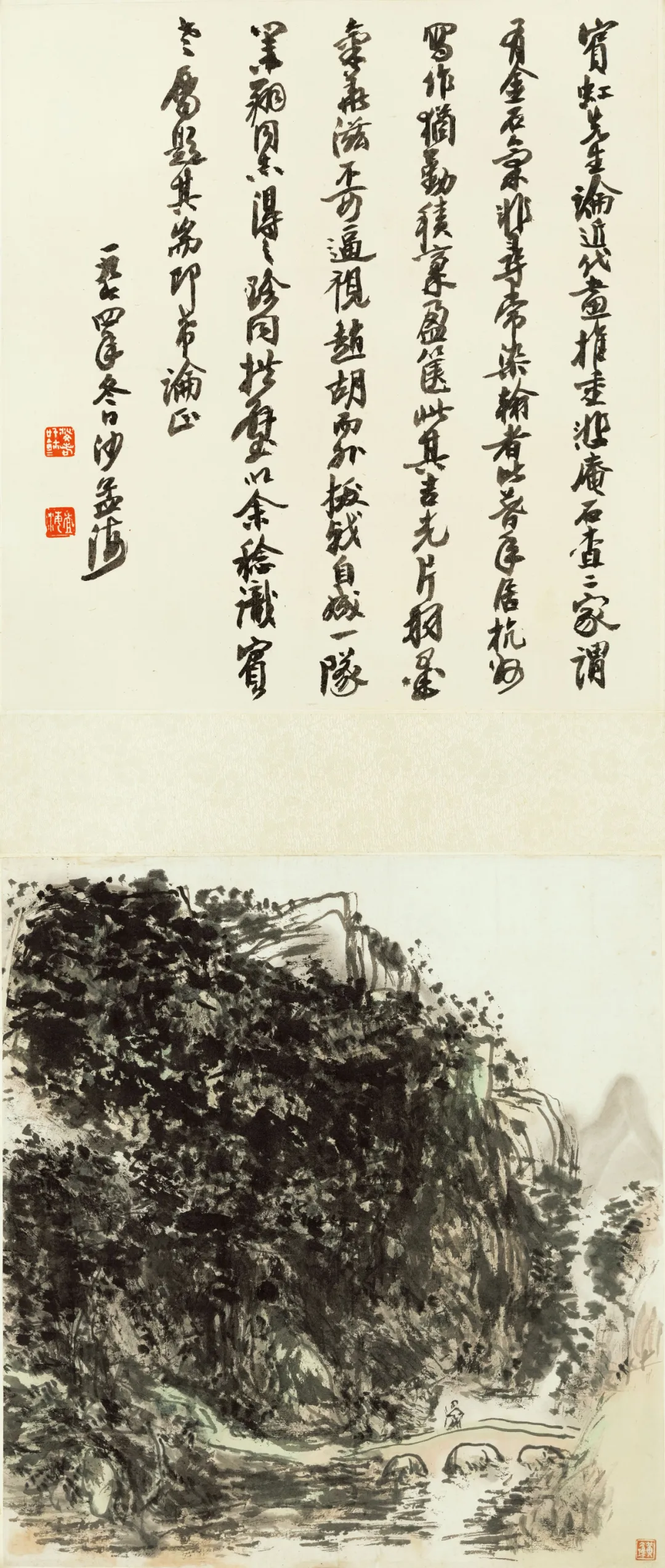
《溪桥图》图中林峦堆烟,青绿赭石之色浓布,构建山峦峻岭之势,密而不透。溪山幽深之处,一石桥跨越双山,溪水细流潺潺,一行人匆匆过桥,隐入山雾之中。画师笔锋犀利,色彩层层点染,构图疏密相间,虚实相生,以规矩中变化无穷,意境深远,如置身仙境。
"The Stream Bridge Scroll" shows forested mountains enveloped in smoke, painted in shades of green and ochre, constructing an imposing range of tightly packed hills. Deep within the mountain stream, a stone bridge spans two hills, with a gentle stream murmuring below as a traveler hurries across, disappearing into the mountain mist. The artist's sharp brushwork, layered color application, and composition balancing density and openness, reality and abstraction, offer a profound and almost mystical landscape.

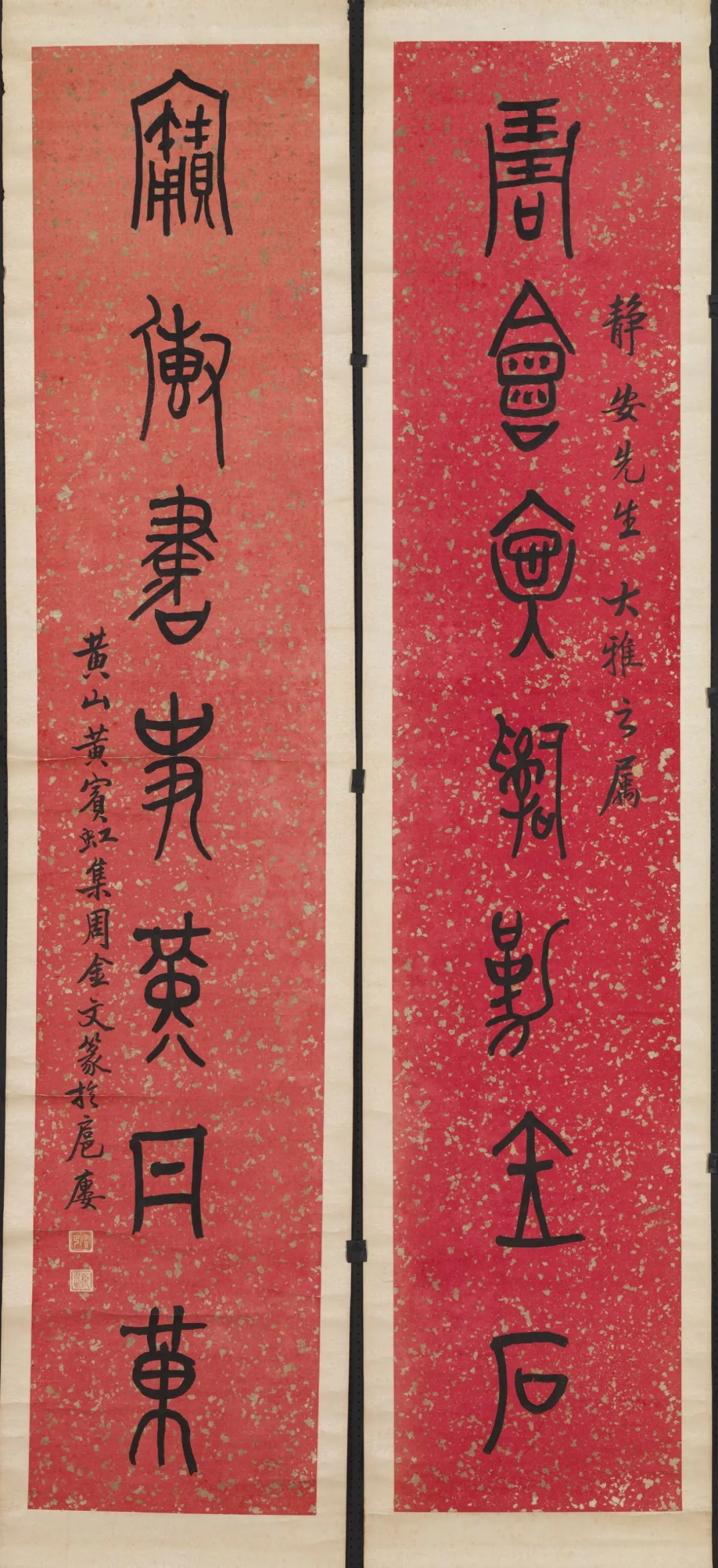
《篆书七言联轴》刻金石之言,铭传丹青之史。黄宾虹集周金之篆文于此轴,行楹联书于其中,文字若隐若现,幽深蕴藉,书法行云流水,留白如故,彰显古人篆刻之精神,文辞凝炼,每一字每一句,皆显大雅之风。
"The Seal Script Seven-Character Couplet Scroll" carves eloquent phrases onto stone, preserving the history of calligraphy. Huang Binhong gathers Zhou dynasty seal scripts in this scroll, elegantly written in columnar couplets, with characters emerging subtly, imbued with depth. The calligraphy flows like water, leaving white space as is, showcasing the spirit of ancient seal carving, with concise and elegant phrasing that radiates the refined taste of the ancients.

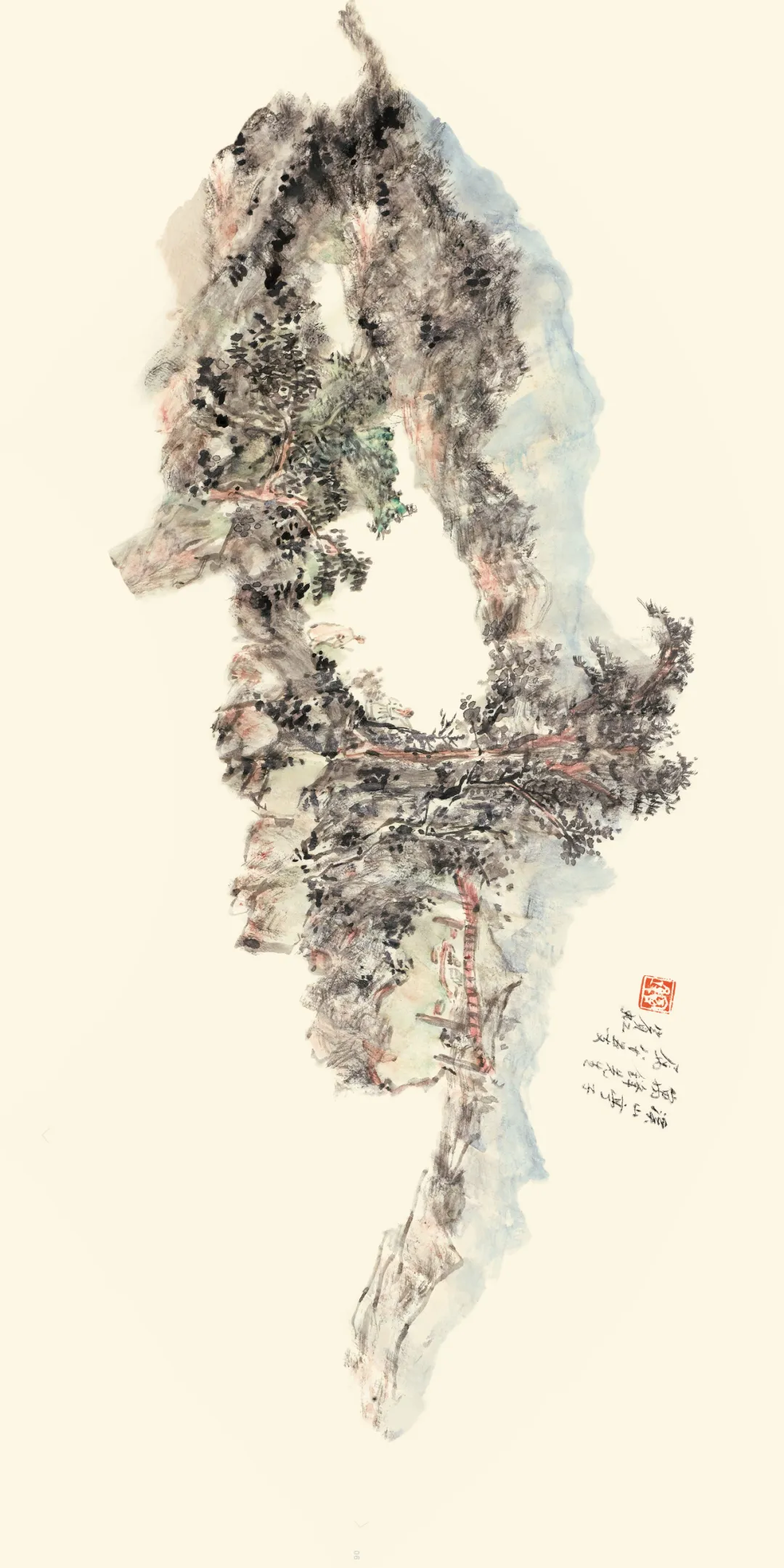
扇上初幅:描绘幽谷之亭,依水而居,石几石榻设其中,供濯足酌茗之便。亭畔古木森罗,绕以碧潭,高山聚石,匠心独运以勾皴点染,仿佛出自谢安独坐高洲之手。澄澈之水池中央留白,宛若仙境,数位行人或坐或立,谈笑自若,真似陶渊明笔下桃源遗民,不知归路。
The initial side of the fan depicts a secluded pavilion in a tranquil valley, situated by the water with a stone table and couches set for washing feet and sipping tea. Ancient trees encircle a clear pond, and high mountains gather rocks around it, all meticulously rendered with fine brushwork, reminiscent of Xie An sitting alone in Gaozhou. The central part of the pool is left blank, resembling a celestial abode, where several passersby, either sitting or standing, chat merrily as if they were the reclusive villagers from Tao Yuanming’s Peach Blossom Spring, unaware of the path back home.
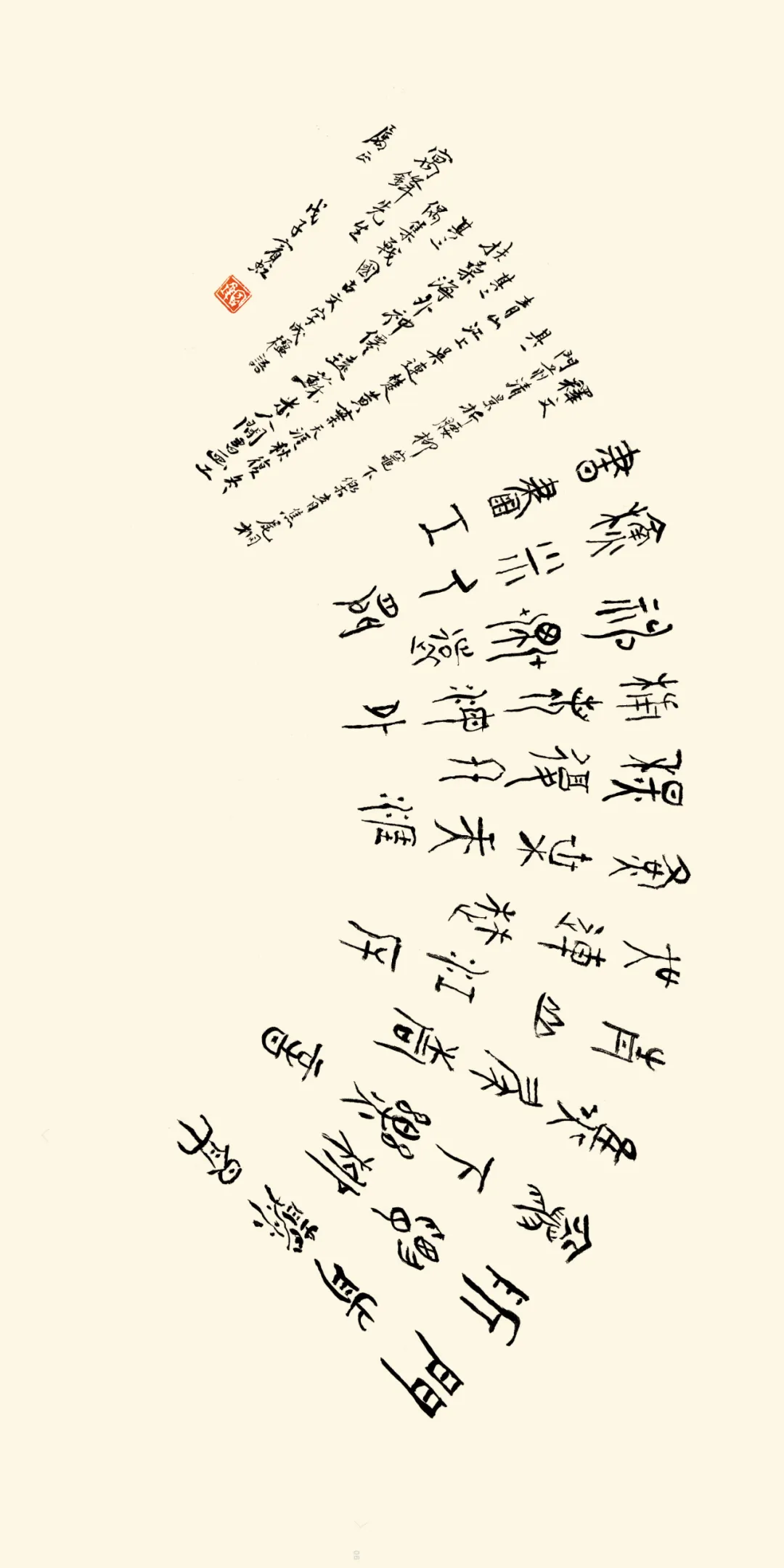
扇上背面:集战国金文,黄宾虹手自楹联,金石为开,意涵深远。首联道:“门前清景折腰柳,灶下乐音焦伟相”,颂古人家常乐,琴瑟和鸣之景象尽现眼前;继之以“青山江上吴连楚,黄叶天涯秋复冬”及“扶桑海外神仙远,苏米人间书画工”,借古喻今,托物寓情,兼具风雅与哲思。
On the reverse side of the fan, Warring States period script is collected, personally linked by Huang Binhong in a couplet, profound in meaning. The first couplet says, "Before the door, the landscape bends the willows low, beneath the stove, the sound of music merges joyously," celebrating the daily joy of ancient households; followed by "Green mountains over Wu across the river, yellow leaves at the world's edge from autumn to winter" and "Beyond the Fusang sea, immortals distant, amidst mankind, a painter and poet sublime," using the past to symbolize the present, embodying both elegance and philosophical depth.
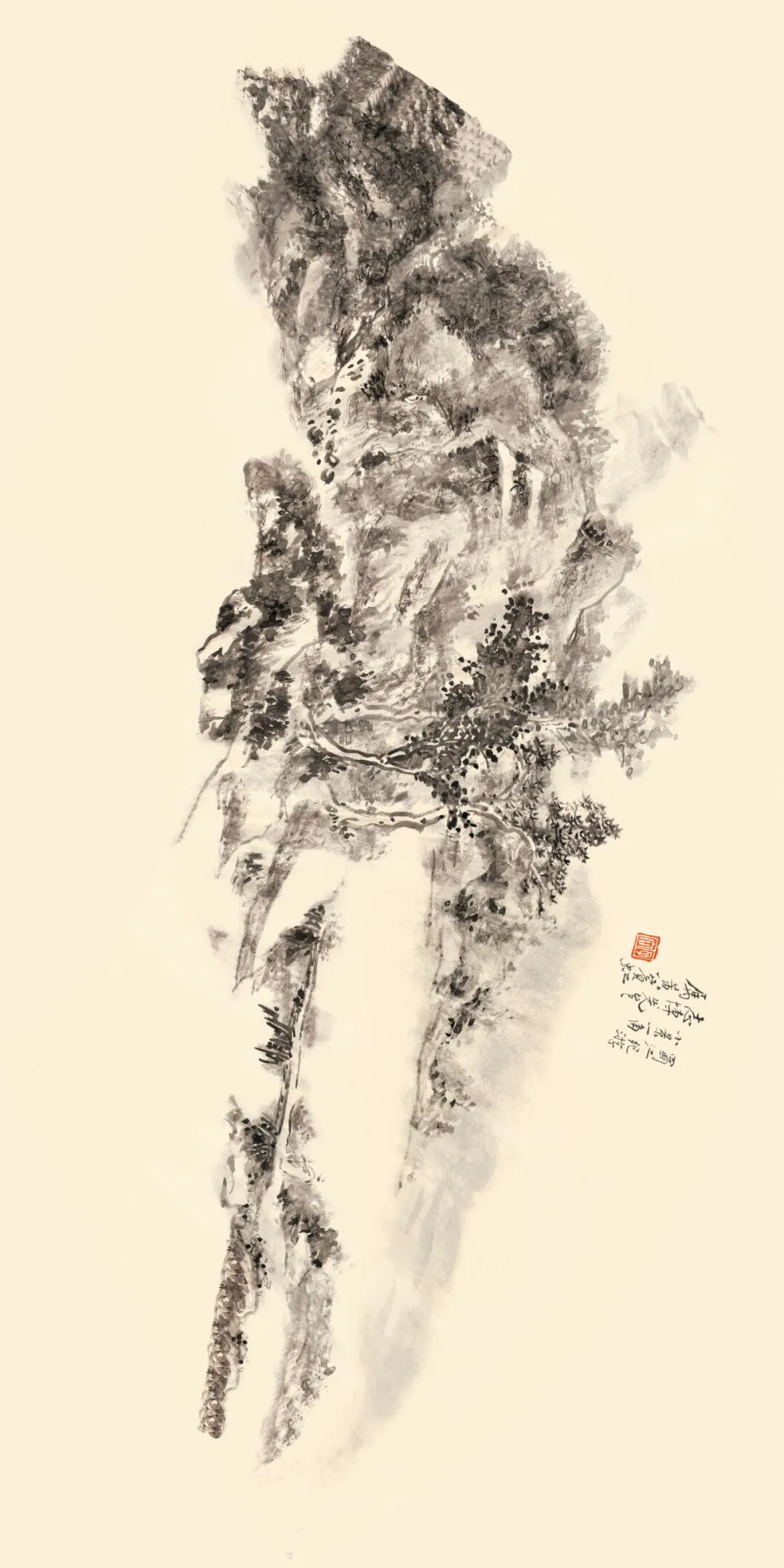
次扇面之正:续前幅风貌,技以层积之法,点染若现,形成早期“黑宾虹”之神韵。意在高远,汲取文人归隐之思,与江南烟雨相融合,笔墨间透露出一种超凡脱俗的新时代精神,恰如宋词中笼烟细雨的江南,诗意盎然,引人入胜。
The next fan's front continues the previous style but with layered staining techniques and pointillism, evoking the early "Dark Binhong" style. The theme is lofty, drawing on the literati's aspiration to retreat into nature, blending with the misty rains of the South, revealing a transcendence unique to this new era, much like the misty rains over Jiangnan in Song Dynasty poetry, enchanting and poetic, drawing one into its beauty.
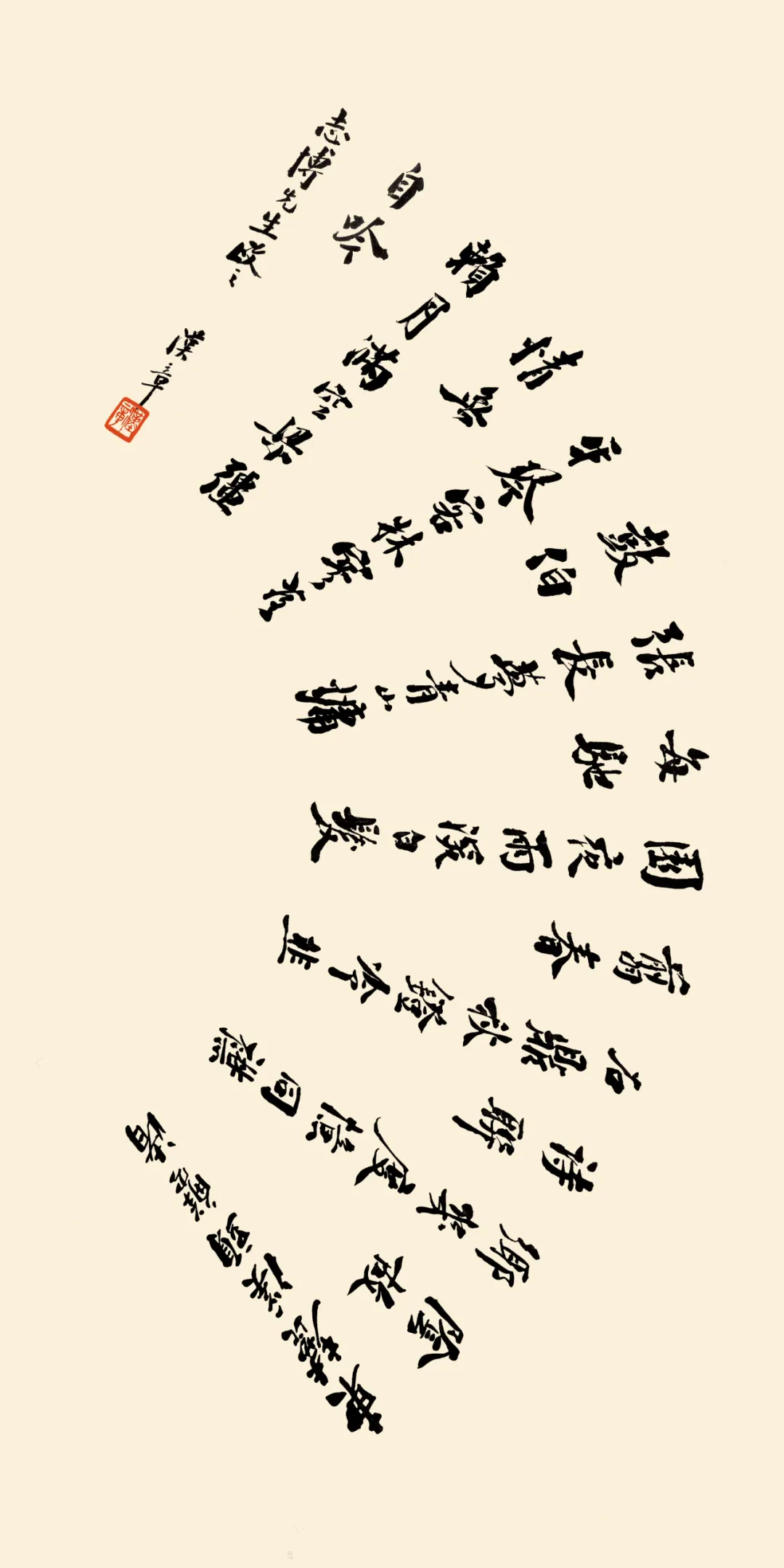
次扇面之背:书写明代朱石《忆乡中诸故友》,句句流露思乡之情,“东麓溪头蟹渚阴,故乡几度忆同襟”,笔下满载离愁,如同杜甫之忆故人,慨然泪下。继以“诗联石鼎秋灯冷,韭剪春园夜雨深”,场景寥落,使人如坐针毡,又似晏殊笔下细雨湿衣看不见。末联“白发每驰张长梦,青山慵鼓伯牙琴,客床廖落情无赖,月满空梁强自吟”,无不透露出诗人在异乡的孤独与忧愁,犹如苏东坡夜泊牛渚之叹,月下孤酌,低吟浅唱。
On the back of this fan, the Ming Dynasty poem "Remembering Old Friends from My Hometown" by Zhu Shi is inscribed, each line dripping with homesickness, "At the eastern foothills by the Crab Islet under the shadows, how often have I thought of my old friends," as if echoing Du Fu's remembrance of his friends, tears unbidden. Continuing with, "Poetry by the autumn lamp next to the cold tripod, chives cut in the spring garden under deep night rain," creating an atmosphere of stark solitude, reminiscent of Yan Shu's lines about rain-drenched clothes unseen. The final lines, "White hair driving forth long dreams, the lazy drumming of Boya's zither by the green mountains, the guest bed empty, forced to sing under a full moon by the solitary beam," reveal the poet's loneliness and melancholy in a foreign land, much like Su Dongpo's sighs by the Niuzhu night, drinking alone under the moon, murmuring softly.



黄宾虹笔墨之用,水法之独,提画论中“七墨”多端,即浓墨、淡墨、破墨、渍墨、积墨、焦墨及宿墨。尤工破墨与渍、积、宿墨。破墨之术,浓淡交融,互相渗透,以自然之力行之于将干未干之际,墨效自显。渍墨、积墨、宿墨,晚年所嗜。渍墨使画中墨色浓郁而边际自然淡出,形成天成之晕;宿墨,习之不洗砚,隔宿旧墨亦用,画时墨黑如青绿,干后清晰可见,用之不当,则作显枯涩。
宾虹之用水,乃画中神髓,一曰接气,二曰出韵,三曰统一画幅。接气者,以水相接,使画面若隐若现,若即若离,用水以连气脉;出韵者,山水无笔迹之处,施以淡墨或水色,使之自然形成,犹大理石之自然纹理;统一者,名曰“铺水”,画至一定之程度,将干未干之际,遍洒清水,以大笔调和,使全幅画面和谐一致,精神充沛。
宾虹之画,乃汇集天地之灵气,融化万物之神采。墨法精微,水法奇巧,皆出自对造化之深刻洞察。虽世人传颂,学者之评述,多未尽其画中之妙味。然观其每一笔墨,每一滴水,皆显画者之独见与心灵与自然之间的默契。观者宜静心细察,方可体味其间之精深,悟宾虹对美学与自然之究极探求。至今,宾虹艺术犹如高山仰止,激励后世无数艺术探索者。其艺途流转如云水,成就一代风范,佳作诸多,使学者嗣后得之深省,研究无穷。
His techniques with ink and unique methods of using water are elaborately discussed in his theories on painting, notably the "seven methods of ink" which include thick ink, light ink, broken ink, soaked ink, accumulated ink, scorched ink, and aged ink. He particularly excels in the use of broken ink and the techniques of soaked, accumulated, and aged ink. Broken ink involves the intermingling of dark and light inks, applying them in a way that they naturally permeate each other while the paper is still damp. The effect of broken ink is also influenced by the direction of the brush strokes. Soaked, accumulated, and aged inks were favorites in his later years. Soaked ink involves the edges of the ink spreading into lighter tones, naturally forming a halo effect; aged ink, often left overnight and not freshly ground, was a regular practice for him, leaving the ink beside his inkstone. His aged ink was so intensely black that it seemed almost greenish in hue when wet but became distinctly clear when dry, exposing any flaws if not handled skillfully.
Huang Binhong's use of water is the essence of his painting, serving three purposes: connecting energy, bringing out the charm, and unifying the painting. To connect energy, he applies water in such a way that the brushstrokes appear both present and absent, achieving a sense of closeness yet detachment. For bringing out charm, in parts of his landscapes where there are no lines, he adds light ink or watercolor, allowing it to naturally form patterns reminiscent of the natural veins in marble. To unify the painting, known as the "spreading water" technique, once the painting reaches a certain stage, he spreads a layer of water across it while it is still damp, using a large brush to harmonize and energize the entire canvas.
责任编辑:苗君